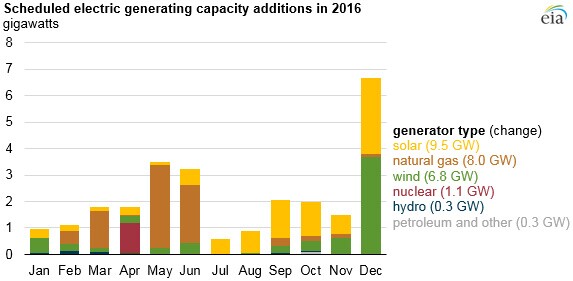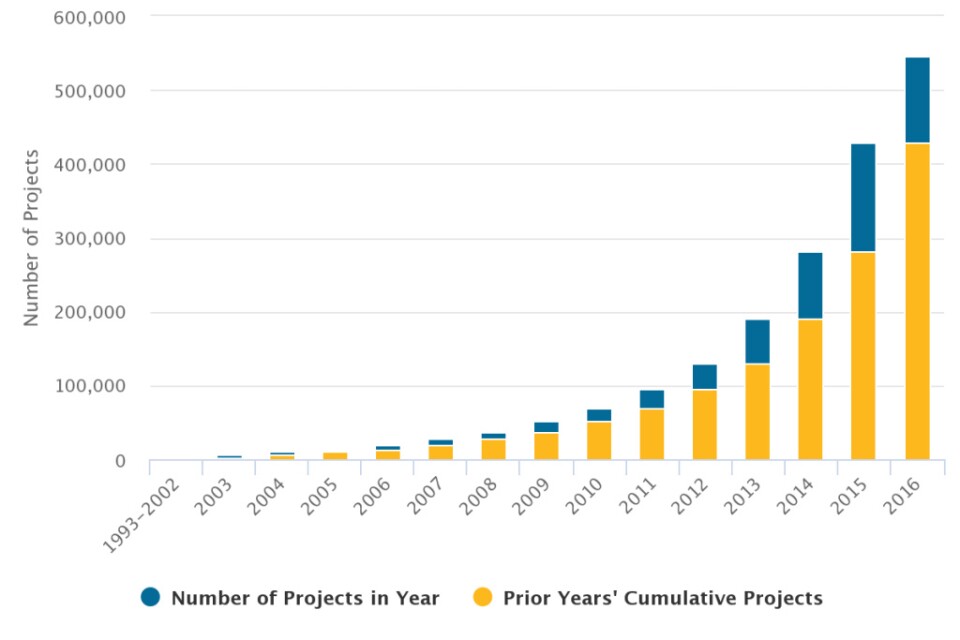With our free press under threat and federal funding for public media gone, your support matters more than ever. Help keep the LAist newsroom strong, become a monthly member or increase your support today.
Solar installations boom nationwide in 2016, but cool in California
2016 is poised to be the biggest year ever for solar energy. More solar power was added to the U.S. electrical grid this year than in the previous three years combined, according to the Energy Information Administration. But California bucked that trend: here, in the nation’s largest solar market, the number of projects built in 2016 is expected to drop below 2015 levels.

To understand why, we need to look at the federal Solar Investment Tax Credit (ITC). The ITC offers a 30 percent income tax cut for people, businesses and utilities that buy solar panels (for more details, read this). It is a huge stimulus to the solar industry, and it was set to expire on December 31, 2016.
Last December, Congress extended the tax credit until 2021. But when many larger, utility-scale arrays were being planned years ago, that wasn’t a given. These projects are owned by or sell power to electric power companies.
“There was a large pipeline of utility-scale solar that was developed basically with anticipation that this tax credit was going to expire at the end of 2016,” said Austin Perea, a solar analyst at GTM Research who recently co-authored a new report on solar trends. “So the second half of this year has been defined by a lot of these large, utility-scale plants coming on line that anticipated the tax credit expiration.”
Nationwide, about 9.5 gigawatts of utility-scale solar were added to the grid in 2016 – more than any other kind of power, including fossil fuels. It’s the first time solar has topped the list of new additions to the nation’s power grid, according to the EIA.
Forty percent of those large solar projects were built in California, aided by the passage of a 2015 law that upped the percentage of electricity that must come from renewable sources by 2030.
But solar isn't having a banner year in California — at least not compared to 2015 when there was a record of 148,000 residential solar projects, up from just over 90,000 the year before. As of September 30, 2016, there have been about 116,000 new residential solar installations, according to the state.

“Now that (the tax credit has been) extended, there’s no longer this pressure,” said Bernadette Del Chiaro, executive director of the California Solar Energy Industries Association. “It was a lot easier to sell a solar system last year than this year [...] But in the long run having that certainty and clear federal tax rules, that makes a healthier market.”
But GTM analyst Perea said there’s another problem in California: many early adopters already have solar panels on their roofs, so that share of the market is becoming saturated. Perea says it has gotten harder for solar panel installers to find new customers, and they haven’t yet expanded their marketing to other demographics or dropped their prices enough to appeal to a wider group of people.
“The question for residential solar installers is how to make solar attractive above and beyond the early adopter demographics that have driven a large portion of the development,” Perea said. “It’s come to a point where customers are just kind of fatigued by the door-to-door marketing pitches.”










